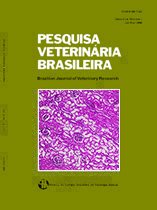 |
|
|
|
Year 2015 - Volume 35, Number 3
|

|
Reproductive endocrine and socio-sexual behavior study of black-tufted-marmoset (Callithrix penicillata) kept in captivity, 35(3):304-310
|
ABSTRACT.- Sgai M.G.F.G., Pizzutto C.S., Viau P., Oliveira C.A. & Guimarães M.A.B.V. 2015. [Reproductive endocrine and socio-sexual behavior study of black-tufted-marmoset (Callithrix penicillata) kept in captivity.] Estudo endócrino reprodutivo e do comportamento sócio-sexual de sagui-de-tufo-preto (Callithrix penicillata) mantido em cativeiro. Pesquisa Veterinária Brasileira 35(3):304-310. Departamento de Reprodução Animal, Faculdade de Medicina Veterinária e Zootecnia, Universidade de São Paulo, Av. Prof. Dr. Orlando Marques de Paiva 87, Cidade Universitária, São Paulo, SP 055508-270, Brazil. E-mail: manuelafraga@hotmail.com
The communication of the female reproductive status in Callithrichidae relies mainly on the socio-sexual behavior, as generally the ovulation is concealed in this primate family by a primary signaling system. In this study the socio-sexual behavior patterns was analyzed in association with the concentration of fecal metabolites of sex steroid hormones progesterone (MFP), estradiol (MFE) and testosterone (MFT) in captive couples of Black-Tufted-Marmoset (Callithrix penicillata), during the different phases of the ovarian cycle. The studied group was composed of four adult couples kept in the São Paulo City Wild Animals Rehabilitation Center. The behavioral patterns were record by focal samplings, with 30 seconds intervals for each observation, five days a week, totalizing 14.400 registers per animal. The measurement of fecal metabolites of progesterone (MFP), estradiol (MFE) and testosterone (MFT) proceeded by enzyme immune assay (EIA). The results allowed to determine the duration of the ovarian cycle and to characterize three different phases (follicular, periovulatory and luteal). It was possible to determine 31 complete cycles that lasted 24.3±4.1 days (Mean ± SD). The follicular and luteal phases lasted 13.04±4.8 and the luteal phase 11.2±4.2 days. The behavioral patterns (scent marking, sniff genitals, grooming and sexual presentation) were more prevalent in the periovulatory phase as the behavioral variable “proximity” as well. There were no variations in the concentration of MFT in the males during the period studied. The associated analyses of the fecal metabolite of sex steroids and the socio-sexual behaviors led to a better understanding of the factors involved in the reproduction of C. penicillata. |
| |
|
|
| |
|
 |